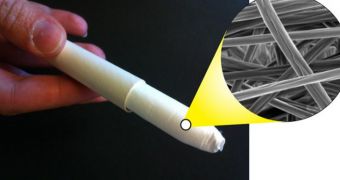Brainiacs claim to have developed a vanishing fabric that they say has the potential to help women better protect themselves against contracting HIV when having intimate relations.
This innovative fabric is the brainchild of researchers with the University of Washington in the US. Its makeup and its working principles are described in a recent paper in the journal Antimicrobial Agents and Chemotherapy.
According to the scientists who worked on developing this fabric, previous studies have shown that, when compared to other topical gels on the market or in the works, fiber materials can hold about 10 times more medicine.
Hence, the University of Washington researchers set out to explore the possibility to use fiber materials to deliver anti-HIV medicine. The fabric they eventually developed comprises silk-like fibers containing a topical anti-HIV drug.
When in contact with moisture, this fabric dissolves fairly quickly and releases its drug content. The scientists say that, should a woman insert a piece of this fabric inside her just before being intimate, the drug would protect her against contracting HIV.
As detailed on the University of Washington's website, the fabric developed by this team of researchers can hold enough anti-HIV medicine to account for 30% of its overall mass. By comparison, topical gels have a drug content of just 3% their mass.
What's more, experiments have shown that, regardless of its drug content, the fabric can dissolve in merely 6 minutes when coming into contact with moisture. By comparison, anti-HIV drugs in film form take about 15 minutes to dissolve in the body.
Commenting on the development of this innovative fabric, study lead author and doctoral student in bioengineering Cameron Ball wishes to stress the fact that “This could offer women a potentially more effective, discreet way to protect themselves from HIV infection.”
“The effectiveness of an anti-HIV topical drug depends partially on high-enough dosages and quick release. We have achieved higher drug loading in our material such that you wouldn’t need to insert a large amount of these fibers to deliver enough of the drug to be helpful,” the researcher adds.
The scientists wish to carry on with their work, and hope to soon pin down the best way for women to use this fabric. Still, before this method of protection against HIV infection becomes available to the general public, the scientists will have to test it on animal models.
“We think the fiber platform technology has the capability of being developed into multifunctional medical fabrics that address simultaneously challenges related to biological efficacy and user preferences,” researcher Kim Woodrow says in a statement.

 14 DAY TRIAL //
14 DAY TRIAL //